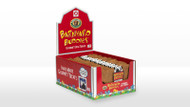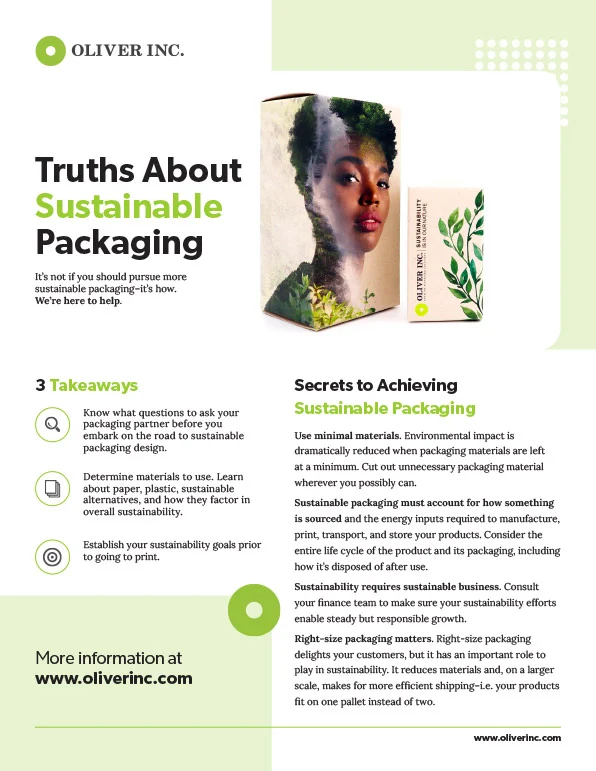Converting Plastic Food Packaging to Paperboard: What to Consider
Posted by Oliver Inc. on 27th Jul 2023
Whether your food company is transitioning away from plastic food packaging to paperboard to save money, experiment with different decorative effects, or become a more sustainable brand, there are several things you should chew on first.
Let’s consider the reasons for embracing sustainable packaging, the advantages of paperboard food packaging, and what you can accomplish with a more renewable substrate.
Why Sustainable Packaging?
It goes without saying, but as the effects of climate change and ecological collapse worsen, more and more consumers are looking for brands who prioritize sustainability. Environmentally friendly food and beverage packaging design features prominently in that shift.
On top of the moral imperative to be stewards of the natural environment, integrating sustainability into your food packaging design comes with several benefits–particularly when converting from plastic food packaging.
A sizable portion of going green centers around building brand affinity among a growing population of eco-conscious consumers.
According to a 2020 report from global consulting firm McKinsey, 43% of American consumers consider the environmental impact of product packaging extremely or very important, and 60% to 70% are ready to pay extra for sustainable packaging.
In other words, consumers want brands to align with their core values.
By adopting more recyclable food packaging, you not only build brand loyalty among eco-friendly buyers, but create more opportunities to generate some PR buzz. It’s quite common for brands to get featured in news stories and shared on social media channels for switching from single-use plastics to greener alternatives.
Ultimately, it’s becoming more and more challenging for brands to overlook their ecological impacts. Consumers expect food brands to lead the way with their sustainability initiatives.
Otherwise, consumers might lose their appetite for your food products.
Advantage of Converting Plastic Food Packaging to Paperboard
As your brand considers making the switch from plastic food packaging, several advantages should be front of mind, including the environmental friendliness, versatility, and cost-effectiveness of timber-based products.
Environmentally Friendly
Paper-based packaging (including folding cartons) is, arguably, more environmentally friendly than plastic, as it is made from renewable, biodegradable, and recyclable materials. On the other hand, determining whether plastic or paper is more sustainable is a complex question and depends on several factors.
Put simply, reducing the use of petroleum-based food packaging can help your brand reduce its environmental impact while appealing to eco-conscious consumers.
People notice when a food brand employs single-use plastics rather than timber-based or other sustainable packaging alternatives, such as hemp- and cotton-based substrates, casein protein, sugarcane bagasse, and, even, post-consumer recycled paper.
Furthermore, only 2% of plastic packaging materials, globally, are recycled, according to an October 2022 paper titled “Need for Sustainable Packaging: An Overview.” The rest end up in landfills, vital bodies of water, or incinerated (releasing more carbon into the atmosphere).
Alternatively, paperboard is vastly more recyclable. In fact, according to the World Economic Forum, 67% of paper recovered was recycled globally in 2021.
So, if your brand is serious about environmental stewardship, you’ll use plastic food packaging judiciously.
Versatility & Creativity
While plastic has a reputation as a convenient food packaging material, it pales in comparison to paper regarding decorative effects and flexibility in design options.
Paperboard is incredibly versatile and creative, as it can be shaped, printed, and finished in a wide range of ways to enhance your product's appearance, functionality, and branding.
As a substrate, it can accommodate foil stamping, embossing/debossing, anti-counterfeiting elements, and laminates and specialty coatings.
Cost Effective
Many factors have to be considered, such as print run size, and decorative effects, but paperboard can be a cost-effective alternative to plastic food packaging. As with its sustainability, many factors go into determining the cost-effectiveness of certain substrates.
According to a study by global market reports provider Smithers titled “The Future of Paper vs. Plastic Packaging to 2026,” substrate costs depend on several determinants:
- Type and quality of the materials used
- Design and functionality of the packaging
- Production and printing process and technology (litho, flexo, and digital)
- Transportation and distribution costs
- Recycling and disposal costs
The report provides a detailed analysis of the cost drivers and trade-offs for 17 different packaging segments, such as bakery, confectionery, dairy, frozen food, ready-made meals, snacks, etc. It even forecasts the market size and growth of paperboard and plastic packaging in each segment from 2021 to 2026, in case you’re wondering what other food brands might be doing.
Ultimately, paperboard is often, but not always, more cost-effective than plastic food packaging, as it may require more material, energy, and space to achieve the same performance and functionality. However, it does offer the benefits of being generally more sustainable, enhancing your brand in ways that typically outweigh its cost disadvantages.
An experienced food packaging manufacturer will help you balance cost-effectiveness with creativity while achieving your sustainability goals.
Moving Away From Plastic Food Packaging
If you’re looking for examples of food brands that have successfully shifted away from plastic food packaging, the stories are plentiful. Here are just a few food packaging transitions from the past couple of years.
Beverage companies have become infamous for employing polyethylene rings to store cans together, which are not biodegradable and ensnare wildlife when improperly discarded by consumers. Alternatively, paperboard provides a powerful solution that is sustainable and eye-catching.
For example, family-owned alcohol brand Fabrizia Spirits uses it to not only secure but carry its product. Its four-pack Vodka Soda comes in a folding carton consisting of premium 18PT CNK stock, integrating a vivid four-color process and aqueous finish.
Adjacent to the food and beverage industry, pet treats can also benefit from shifting to more sustainable alternatives.
Gourmet dog treat company Barnyard Buddies utilizes paperboard in its shelf-ready food packaging. Mirroring the shape of a traditional barn, its paper-based packaging secures the dog treats and improves the shopper experience, while shifting away from plastics.
Chocolate and candies have commonly been wrapped in polypropylene.
However, chocolate brand Evolved integrates paperboard into its minimalist food packaging design. Printed on 16PT C1S FSC stock, not only does the product catch your eye, but its sustainable packaging stands out on shelves.
So, as you look to transition away from plastic food packaging toward paperboard, you’ll want to consult with a seasoned food packaging supplier that understands the ins and outs of sustainable packaging.
It will help you identify whether paperboard or plastic makes the most sense for a particular food product and your brand, while enabling you to reach the growing number of environmentally conscious consumers.






